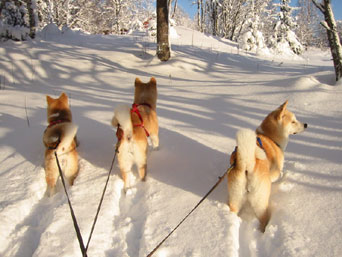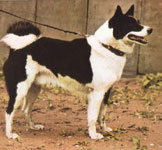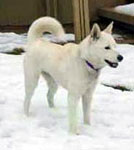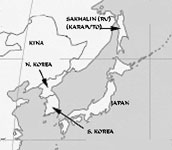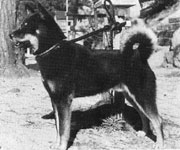|
- the dog from the land of the Samurai.
By
Britt Nyberg, 2004
Revised Nov. 2005
Japanese dogs
The first impression
that the Japanese dog creates is a lack of sophistication
- a touch of nature that has escaped man’s selected breeding.
Eyes are the
critical point for distinguishing Japanese dogs from Western dogs. The eyes of a
dog, irrespective of type and breed, generally reflect a shade of appeal,
fawning or plaintiveness. This is a shade especially evident in the Japanese
dog. They have almost triangular, deeply set eyes under thick eyelids. Looking
lonesome and quiet, their small triangular eyes suggest the burning spirit
within.
Toughness is
another feature of the Japanese dog. Sturdily built, he rarely falls ill. He can
live on coarse food and is not fastidious about meals. He can withstand both
cold and heat well.
Calm and
considerate by nature, the Japanese dog understands how man thinks; he remains
good friends on tacit terms.
Japanese dogs
are classified by size, colour, background, place of breeding and use. By use,
they are wild boar dogs, deer dogs and so forth. In fact, the Japanese dogs are
so much alike that in Japan, these native breeds were once classified as one
group, divided into sub-groups: large (Akita), medium (Kai, Kishu, Hokkaido,
Shikoku) and small (Shiba).
Akita –
The leader amongst Japanese Dogs
The
Akita dog
got his name from his home – the Akita Prefecture on the northern part of the
Japanese main island Honshu. This is the most representative Japanese dog.
Well-balanced in build (today’s males average height: is 67 cm; weight: 35-40
kg), the Akita dog is believed to have been medium sized originally. He was
earlier called Akita Inu but since the word “Inu” merely means “Dog” it was
dropped from it’s name when the standard was revised in the 90’s.
It is just in
the past few decades that this breed settled into it’s present form. With
upright triangular ears and recessed eyes, the Akita dog looks very clever. It’s
stout build, smart conformation as well as thick, forceful coiled tail and
sturdy legs add to the dignity and gracefulness of the dog. The Akita has a keen
eye and nose, silence and speed. It has a durable sturdy body suitable for
hunting in deep snow. The breed also was developed to retrieve downed waterfowl.
Although it has the strength and dentition which can crunch through frozen
carrion, its "soft" mouth when retrieving and delivering quarry to the hunter's
hand ensures downed waterfowl is never mangled. Akitas are even said to have
been used to drive fish into waiting nets.
Several Akita
dogs have red fur with white markings “urajiro”, like a touch of make-up, on
their jowls, their legs, throat, belly and under their tail (like they have
dipped their feet and face in a bag of flour). Such dogs are held to be
especially beautiful.
The brindle
Akita dog recalls the sober Samurai and is believed to be especially composed
and dignified. He is claimed to possess the latent power suggestive of a master
of kendo, the way of the sword. The white Akita has been admired since ancient
times as having the colour that signifies cleanliness to which the Japanese
attach almost religious feelings.
The variety of
colouring adds to the impression of dignity, simplicity, steadiness and charm.
Varied rich and pure colours is improtant to breeders of Akita dogs in Japan.
The characters
of these dogs suggest ancient Japanese people - dignified, austere, valiant,
courageous, faithful, alert, good-natured and gentle, highly affectionate and
sensitive to their masters.
The Akita
thrives on companionship. It is fearless, intelligent, and has a somewhat
stubborn attitude. It is reserved in demeanour with a strong protective
instinct. The Japanese say he is "tender in heart and strong in strength." The
breed's popularity continues as a companion and guardian.
Like Japan's historical warrior class, the samurai, the Akita was used as a
fighting dog in the late 1800s and early 1900s. During this period, other breeds
were infused to enhance its fighting ability. However, after the Akita was
declared a national monument in 1931, a movement began with the goal of
restoring the breed to its original form.
|

Akita
statue |
The Akita has
spiritual significance in Japan. Small statues of this dog are typically given
at the birth of a child to ensure health, happiness, and a long life. They may
be given during an illness as a get well wish. Statues also stand guard over
many tombs of the dead.
Even though an
Akita is a large dog it doesn’t demand exercise in the mount expected. As all
other dogs it naturally benefits from hard exercise and mental exercise, but
should the exercise sporadically not be consistent, it won’t show on the dog.
Personally I find this a valuable quality in a family dog. As everyone is aware
of, the interest in taking the dog out for long walks isn’t shared by all the
members of the household, and a dog that is unable to relax without it’s
necessary exercise, could easily become a source of irritation. The Akita is by
nature, a calm dog who becomes very attached to it’s family. He is often
reserved with strangers but if they are “dog persons” or family acquaintances he
will easily become exuberant when he recognizes them and greets them.
Ancient history
In ancient times,
dogs were used for hunting and as sources for food and fur and the history of
the Japanese dogs dates back to the outset of Japan’s recorded history. Skeletal
remains from the Jomon Period (about 7000 B.C.-200 B.C.) of small and medium
sized dogs and a few remains of somewhat larger dogs, resemble skeletons of the
Japanese dogs of today. They stood 37 to 50 centimetres at the shoulder. A
shell-mound in Miyagi has yielded a few large dog skeletons of about (59 cm)
23.2 inches. Almost all of these dog skulls have a straight nasal bridge. The
uncovered remains indicate that the dogs in those days were yellow or reddish
brown or grey of the Southeast Asian Pariah species.
Dog figurines
and clay images, dog-patterned earthenware and copper musical instruments,
bronze temple bells, as well as dog bones have been unearthed from burial
mounds. These findings suggest that dogs co-existed with men as early as the
Stone Age. Hunting scenes depicted that period also show Japanese dogs of that
era with erect ears, curled tail and occasional sickle tails.
Dogs
accompanied every racial migration in history; as the type of dog varied with
the race. The present distribution of dogs is said to offer a clue to ancient
racial migrations. The modern Japanese dog has developed through repeated
selection of the dogs that settled in Japan.
In
660 B.C., dogs were brought to Japan from China and Korea (eg. black pinto dogs
that resembled Japanese dogs of today) and in the Yayoi Period (200 BC – 300 AD)
when farming began, Eurasians, who drove the Ainu people, who previously had come to the Japanese islands
from Russia, to Hokkaido. The dogs they brought with
them mixed with indigenous dogs, and probably the Japanese wolves “Hokkaido” and
“Hondo”, and produced the Spitz type dogs.
The Ainu lived
in the northern through the middle parts of the Japanese main island, Honshu, in
former days. But as the Japanese race gradually extended its borders to the
northern regions, they withdrew into the northern part and finally settled in
the island of Hokkaido.
The dogs that accompanied them are presumed to be the ancestors of the present
Hokkaido dogs.
Biochemical analysis from studies done by Mr.Yamakawa in 1980 (Biochemistry
Department, Tokyo University), show that the glycolipid (which is genetically
inherited), N-acetyl neuraminic acid (the Western type) is found in the
Akita, Hokkaido and the Chow Chow, while the glycolipid, N-glycolylneuraminic
acid (the Oriental type) is found in the Shiba dogs, Kai dogs, Shikoku dogs,
Tosa dogs and Pekingese. The research data definitely indicate that the Akita
dog came to Akita from Europe via the U.S.S.R. and Hokkaido, while the Oriental
type dog such as the Shiba dog came from China to Korea to the Hiroshima area.
Early
History
From
200 B.C.,
Japan made cultural exchanges with the Asian Continent including China,
Korea and other countries, and imported many dogs. In Japan’s oldest historical
document, the "Kojiki" (Japan's Ancient Chronicle, 712 A.D.) and the
30-volume "Nihon Shoki" (The Chronicle of Japan, 720 A.D.) and other
literature, record the importation of dogs on several occasions, particularly
white dogs were mentioned, with tales of dog's loyalty to his master and their
hunting abilities. Hunting dogs were used with trained hawks for almost 1500
years from around 355 to the mid 1800s. Entered just as koma (Chinese
name for “dog”), many of them were small lap dogs, hawk hunting dogs and big
dogs from Ch’itan, China. These imported dogs, together with a number of
unrecorded ones, must have affected the growth of the indigenous Japanese dogs.
Ownership of
one of these dogs was once restricted to the Imperial family, the ruling
aristocracy and the Samurai. Detailed care and feeding rituals were developed as
well as a special vocabulary called “dog words” used to address the dog on the
hunting fields or when talking about them. Specially decorated leashes were used
denoting rank and standing of the dog and its owner. Each dog was assigned a
special caretaker who, dressed in ceremonial garb, signified his relationship to
the dog and its status in the realm.
|
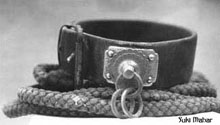
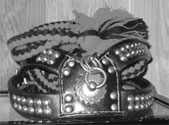
Akita collars and leashes |
By nature, the
dog has a sharp nose. However, this appeared to be highly mysterious to Japanese
in ancient times. Naturally dogs therefore came to play an important role not
only in superstition but also in fairy tales.
|
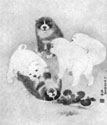 |
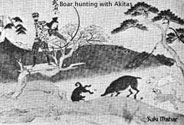
Wild boar hunting
(Photo by S. Mahar, knl Awoyama, USA) |
Picture scrolls
from the late Heian Period (794-1184) to the Kamakura Period (1185-1333) show
dogs with erect ears, curled tails, and some with sickle tails. Dogs are
colourfully illustrated together with birds on scrolls drawn by a Buddhist monk,
Sojo Toba (1053-1114), of the Osanji Temple. There are also illustrations of
puppies at the Kukaiji Temple, and a picture scroll showing boar hunting
techniques. Dogs with droopy ears are seen more and more in later drawings.
Although pintos
(coloured dogs with extended white markings) appear the most in these
illustrations, it is not known whether pintos were a common sight at that time
or were illustrated for convenience and colouring scheme. However photographs of
the early 1900s clearly show many black, brindle and red pintos.
A heavier
influx of foreign dogs occurred around 1570 with the opening of the port of
Nagasaki to the westerners.
Dogs
Rule the Country
Notorious is Tokugawa Tsunayoshi
(1646-1709), the 5th Tokugawa Shogun in the Edo Period (1600-1867).
This Shogun issued a law against cruelty to animals, designed to embody his
Buddhist ideals of mercy. The “Law of Compassion for Living Creatures” ("Shorui
Awaremi-no-Rei") stated that people should pay more respect to animals, as
represented by dogs, than to people. Any violation, no matter how minor, led to
imprisonment. The law prohibited killing and injuring animals and demanded
people to give them loving care. The law and punishment ignored human rights in
favour of the rights of dogs. As the law stipulated that sick and injured dogs
had to be treated, this period witnessed the development of the profession of
dog doctors. The law also stipulated that the sex, colour of fur, and age be
reported to a specially created office; Inu-metsuke, or dog
superintendent officers, made a regular round of the streets. The dog
registration from this period now provides a valuable reference concerning the
shape and features of the dogs of the day. The preservation of the dog registry,
called the "Kazukesho", lists coat colours of dogs from that period.
Colours mentioned are: white, red, black, black brindle, brindle pinto, black
pinto, reddish black and light red. However, it is not known if these dogs were
all of the Japanese type.
As the law
became more and more severe, an increasing number of people discarded their own
dogs to avoid trouble, and abandoned dogs increased in Edo (old Tokyo). To house
them, the Shogunate set up doghouses in spacious lots in many areas and in 1697
the number of these dogs totalled 48,748 (som sources say that the total was
100,000). Naturally the maintenance costs involved a tremendous sum.
It is to say
safe that the dogs controlled the country during this time.
Shogun Tsunayoshi was called the Dog Shogun for his exceptional preference. But
his dog kingdom did not last long. Upon Tsunayoshi’s death in 1709, the
notorious law was rescinded, much to the joy and relief of the people, who had
been tormented by dogs and punished for any retaliation. Ultimately Tsunayoshi’s
favouritism toward dogs turned out most unfavourably for them. The result was
many stray dogs wandering in and around Edo.
Ancient times to the
Meiji era (until 1868)
During the Tokugawa period (1600-1868) more than 70 revolts (ikkis)
occurred in Akita-han (a former governmental unit of the Akita Prefecture).
There were two peak periods. One was against the new Satake administration and
the land survey (kenchi) around the Keichou and Genna eras (1596-1623).
The other was triggered by famines experienced during the Tenmei (1783-1788) and
Tenpou (1830’s) eras. The worst famine claimed more than 7000 lives in Akita-han
alone. It occurred in 1783 and was called the “Rabbit Year Starvation”.
Unstable social
conditions, due to the various factors mentioned above, caused much anxiety
among residents of the area and forced them to prepare for self-defence. The
first step was to acquire a guard dog. This meant using the matagi-inu for a
different purpose than previously.
|
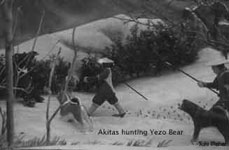
(Photo
by S. Mahar, knl Awoyama, USA) |
The ancient
Japanese word matagi, meaning esteemed hunter, was bestowed on the best
hunters in a village. Historically, the Akita Inu (or the dog from Akita) was
known as matagi-inu (esteemed hunting dog) by the hunters of the northern
Prefecture of Akita, who used pairs of dogs to hunt deer, wild boar and the Yezo
bear. When hunting the Yezo and wild boar, two dogs held the prey at bay until
the hunter arrived with spear or arrow. Akitas were highly prized because they
hunt silently.
Since that time
it has been traditional for people in this area to keep dogs. Matagis kept
hunting dogs while wealthy farmers and old influential families kept guard dogs.
In the areas surrounding Odate, some families started using their dogs for
fighting. Exactly when this began is unknown. According to oral traditions, most
families owned one or two fierce dogs. Renowned old families in particular,
raised dogs all of the same colour from generation to generation as if they were
family crests. These dogs were known by their colour and the owner’s family
name. Some examples are “White of Adachi”, “Brindle of Benzousama” and “Black of
Izumi”.
Matagi dogs
also include the Hokkaido, Kishu, Kai dog and the Shikoku dog which have carried
on the blood of the Japanese hunting dogs. They have well-developed shoulders
and the inherited courage that will not concede a step before danger. They are
matagi dogs fresh from the wild; they look curtly calm but their triangular eyes
suggest a fierce and wild spirit inside.
The primary requirement for a good hunting dog is its ability to perform the
required hunting tasks. For guard dogs however, an imposing appearance is
probably more important. It is assumed that the preference for larger and more
substantial dogs influenced breeding, thus resulting in a gradual increase in
the size of the dogs. This laid the foundation for the development of a
large-sized Japanese dog eventually called the Akita.
|
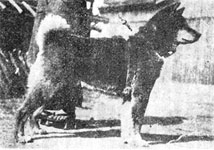
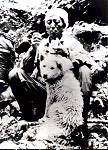
Matagi-inu,
hunting dog |
Actual
documentation of large-sized dogs of the Akita type’s existence didn't occur
until the early 17th century when a nobleman, Lord Satake, exiled to Akita
Prefecture (a northern province on the island of Honshu from which the breed
takes its name) encouraged the local aristocracy to develop a powerful hunting
dog that possessed superior intelligence and courage. This was when the Akita
breed’s history began and it was the Samuraj (the aristocracy/warriors) that
introduced dog-fights as a sport and developed the Akita breed. During the
Tokugawa era the importation of dogs from the European continent was a
prosperous business, and a new word, "kara-inu," meaning "foreign dog,"
was coined.
The Samurai culture
To better
understand which qualities
the Samurai
appreciated in the dogs, a short introduction to the Samurai culture is in
place. The Japanese Samurai wasn’t just a feared warrior who excelled in
the usage of all sorts of weapons, but also a central figure in the Japanese
Community dealing with administering and promoting cultural issues.
From the 11th
Century on to 1868 the Samurai and his way of life was looked upon with awe and
gained many followers. Naturally this wasn’t entirely good. Nevertheless the
culture of the Samurai class gradually came to characterize the Japanese Society
and is still reflected in modern community life in Japan today.
The word
Samurai was first used around the 11th Century when the powerful landowners
armed servants began calling themselves Samurais (=somebody who serves
somebody).
The Samurai culture founded upon three pillars:
Konfucianism,
Zenbuddhism and ”Bushi do”.
The Japanese
Society was feudal up until 1868. From the 17th century the society
was divided into three clearly defined classes. The Emperor, the Court
Aristocracy, and a few other occupational groups such as doctors where not
affected by the classification. In the Society there also existed ”unclean” or
”none people”. These people were occupied with jobs that were thought of as
unclean, but that had to be done.
The society was
classified into the following classes:
The Samurai
class which consisted of the Shogun (the country’s political and military
power), Daimyo (the Shogun’s closest vassals), Hatamoto (vassals who served the
Shogun personally), including other military aristocracy. After the samurai
class followed, in order: farmers, craftsmen, artists and priests. The merchants
were in the lowest class as these were people that were not to be trusted.
Konfucianism
= A system consisting of moral obligations and commitments which rested upon
five conditions which regulated relations between the superiors and the
subordinate.
Zenbuddhism
= More a way of life than a religion. Zen endeavours to move the mind into a
state where the sk. spontaneous intelligence can work freely. The spontaneous
intelligence exists in a mans subconscious and can be reached if one manages to
detach the conscious control of ones actions.
Bushi do
= The word means ”the way of the warrior” in Japanese. “The way” in this context
means conduct and behaviour regulated by a sort of ethical codex. At the
beginning, this rule as to how the warrior was to behave was only a verbal
tradition and a matter of upbringing from childhood. A more complete codex in a
written form appeared in the 17th century. Bushi-do’s main principals
were simple and easy to abide by:
-
Courage at
the moment of threat and never to leave one’s post.
-
Loyalty
towards one master.
-
A simple
way of life.
-
One has
always to be honest and righteous.
Under these
titles existed many subtitles which dealt with endurance and bravery,
humaneness, courtesy, sincerity, a sense of honour as well as devotion. Despite
that the Emperor Meiji abolished the Samurai system in 1868, the Samurai
culture’s three foundation pillars: Konfucianism, Zenbuddhism and
Bushi-do were kept in a modernised form. These three pillars from the Age
of the Samurai still are an active component in the modern Japanese Society, a
living tradition and often without the individual being aware of it.
Medieval times
Little is known about the fate
of all the dogs left to wander in Edo after Shogun Tsunayoshi’s reign. An
article in “Dog Lecture, Japanese Dog” states: “Around the time of the
Sino-Japanese War (1894), many feral dogs lived in the inner and outer moats of
the Edo Castle. The large numbers of pine trees growing in these moats and the
fact that they were off-limits to the general public, created an environment
favourable to the dogs. Near Ochanomizu in particular, many areas contained
ravines inaccessible to humans. The wild dogs found shelter during the day in
these places, and at night they would emerge to scavenge for food in the city.
The nearby residents called them Odate-inu (embankment dogs, who received
their name from their home town).
Among these
were packs of pure Japanese dogs with about 20 to 30 individuals in each. Most
of them were black and white or pinto in colour. Although there is no conclusive
evidence that these feral dogs known as Odate-inu were descendants of the dogs
raised by Tsunayoshi the “Dog Shogun”, their presence in the heart of Edo
(Tokyo) for two centuries (until about 1894) supports this belief. Their
survival was certainly because of feral breeding and natural selection resulting
in large and strong individuals. In the Tokugawa period, the Sankin system
promoted trade between Edo, the cultural centre, and outlying regions.
Therefore, it is also possible that crossbreeding took place between the
Odate-inus and other regional dogs, which accompanied their masters to Edo. |


